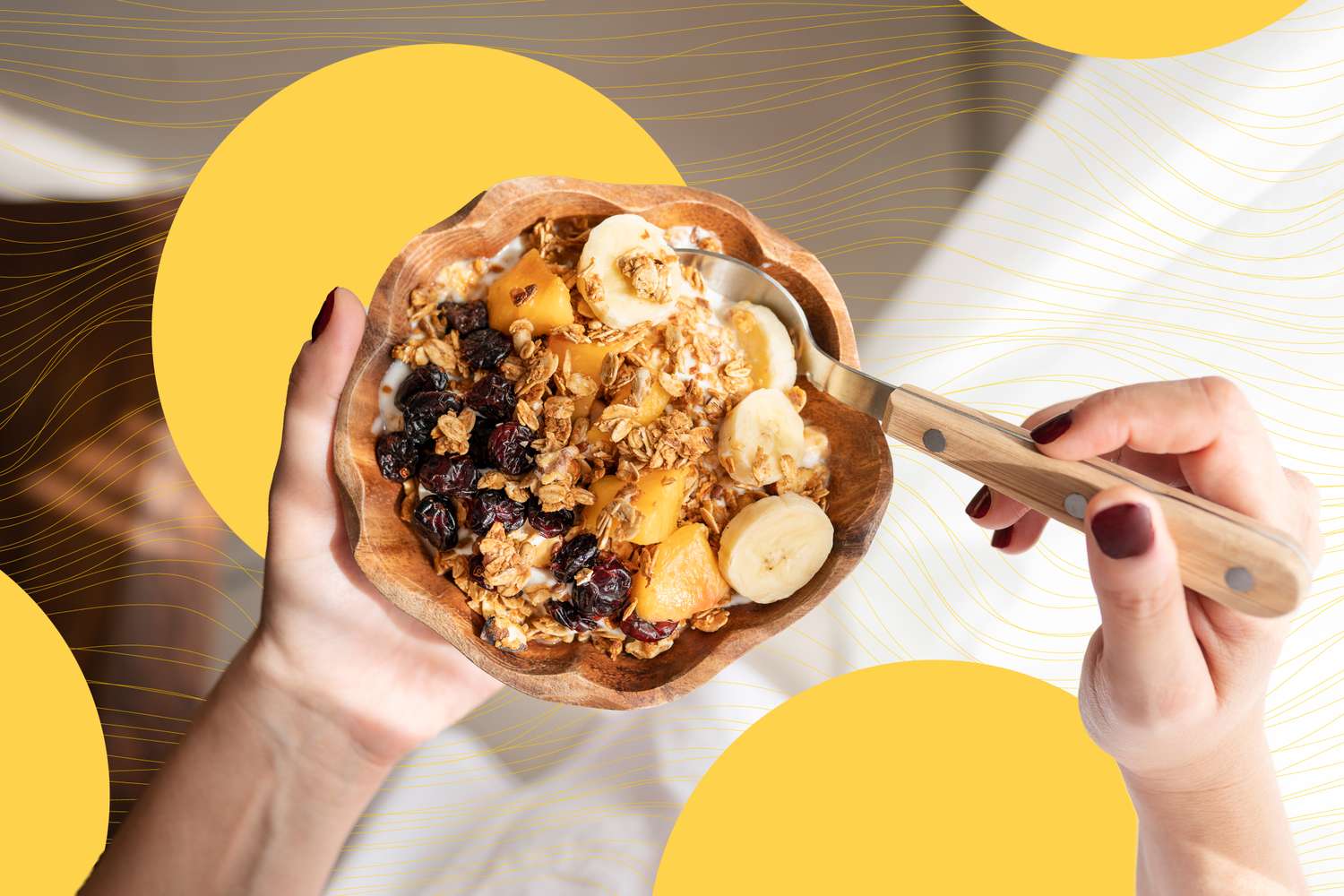
Crunchy, chewy and loaded with oats, nuts and dried fruit, granola sounds like a nutritious breakfast or snack. And it can be, especially when it’s made with healthy, whole food ingredients. What’s not as obvious, however, is that some brands of store-bought granola can be packed with added sugars and unhealthy fats. That can quickly turn this seemingly nutritious choice into a calorie and sugar bomb.
The good news is, there are lots of healthy brands out there. So, we asked six dietitians how to choose the healthiest store-bought granola. And they all told us the same thing. Read on to learn their top tips for picking a granola that’s as nutritious as it is tasty.
All our RDs agree that keeping added sugars to a minimum is a must. “Excessive added sugar intake is associated with poorer health outcomes like heart disease, type 2 diabetes and liver disease,” says Christina Chu, M.S., RD, CSSD. And granola can be a sneaky source.
Finding those added sugars can be trickier than it sounds. “Sugar is the master of disguise,” says Bonnie Taub-Dix, RDN, who points out that sugar can be found in granola under many different names. That’s why she advises reading the ingredient list closely. When you do, look for ingredients like organic cane juice, molasses, honey, coconut sugar, maple syrup or brown rice syrup. Although these may sound healthy, they all deliver added sugars, which most of us eat too many of to begin with.
It’s also good to know that added sugar is different from total sugar, which can include natural sugars from healthy ingredients like dried fruit. So, total sugars aren’t as much of a concern as added sugars. Look for brands with less than 6 grams of added sugar per serving, says Vandana Sheth, RDN, CDCES, FAND. “When you keep added sugar low, it can help prevent quick blood sugar spikes and keep your granola more balanced,” she adds.
“Find your fiber,” says Amanda Blechman, RD, CDN. Fiber-rich foods help keep you full, support steady blood sugar, keep your digestive system regular, promote gut health and help maintain a healthy body weight.
“Most of us don’t meet our fiber needs, so choosing a granola with whole grains, nuts and seeds can help contribute to that,” says Diana Mesa, RDN, LDN, CDCES. Dried fruits like dried figs, apricots, prunes or dates can also help boost fiber.,
If you’re wondering how much fiber to look for, Blechman recommends at least 2 to 3 grams of fiber per serving.
Depending on the brand, store-bought granola can be a surprising source of protein. “Look for a granola with a variety of whole grains, nuts and seeds to help meet your protein needs, support muscle growth and have more staying power,” says Mesa.
Protein can also help keep your blood sugar stable, says Taub-Dix. She recommends choosing one with at least 5 grams of protein per serving. And if you can find a brand that contains quinoa, grab it. Quinoa is 60% protein. Unlike most other grains, quinoa boasts complete protein. That means it contains all nine essential amino acids your body needs for optimal protein synthesis.
In addition to hidden sugars, granola may also sneak in less-than-healthy fats. “Many granolas contain saturated fat from coconut oil, palm oil or butter,” says Taub-Dix. “Go for granola that provides healthy fats like those that come from nuts, seeds or natural oils.”
However, it’s not just about the type of fat. The amount also matters, as too much energy-dense fat can add up to lots of hidden calories. A good goal, says Chu, is less than 20% of the Daily Value from fat. While you’re looking this up on the Nutrition Facts panel, don’t forget to check out the serving size. Sometimes, they can be as small as ¼ cup!
“It’s becoming more and more common for granola blends to contain a variety of new types of grains, seeds and nuts,” says Blechman. While these ingredients can add extra nutrition, it’s also important to be aware that nuts and seeds are common allergens, she says.
“Choose a granola that meets your food allergy and/or dietary restriction needs,” advises Tessa Nguyen, M.Ed., RD, a dietitian who specializes in food allergies. “No matter how popular a certain flavor or brand may be, if you can’t safely eat it, then it’s not going to be the healthiest choice for you!” If you or your family members have food allergies, scrutinizing the ingredient list is a must.
Granola isn’t just for your cereal bowl. For even more creative ways to add it to your day, try these dietitian-approved tips:
Granola can be a healthy choice, but it’s only as good for you as the ingredients that go into it. To choose the best store-bought granola, dietitians recommend looking for a brand that’s low in added sugars and contains fiber, protein and healthy fats. To find out for sure, read the Nutrition Facts panel and ingredient list. If food allergies are a concern, the ingredient list can also help you spot ingredients you’re allergic to.
As tasty and satisfying as granola is with a splash of milk, there are loads of healthy ways to enjoy it. Sprinkle it over yogurt, toast, chia pudding, sweet potatoes or even salads. Or, try it as a nutritious topping for a healthy fruit crumble. With the right ingredients, it’s a delicious, healthy way to get your crunch fix!

Dr. Suzuki, a professor of neuroscience and psychology at New York University, recently appeared on The Diary of a CEO podcast hosted by Steven Bartlett. She later posted a clip of the discussion on Instagram, highlighting one of the most frequent questions she’s asked: “What’s the ideal amount of exercise for a better brain?”
Drawing on years of research, Dr. Suzuki explained how even moderate aerobic activity can lead to measurable improvements in brain function. Her lab conducted a study involving individuals who had exercised for less than 30 minutes over the past three weeks—essentially, “low-fit” participants.
The participants were asked to engage in a 45-minute aerobic activity, like a spin class, two to three times per week. The outcome? “Their mood got significantly better, their memory function improved, and their ability to shift and focus attention got significantly better,” Suzuki revealed.
These changes are closely tied to the hippocampus and prefrontal cortex—two key brain areas involved in memory, focus, and emotional regulation.
What about people who already exercise regularly? Dr. Suzuki didn’t leave them out. In a follow-up experiment, her team collaborated with another spin studio, offering participants the freedom to work out as often as they liked, up to seven times a week. The findings were striking: “Basically, every drop of sweat counted,” Suzuki said. Brain scans revealed enhanced function in the hippocampus and prefrontal cortex, along with noticeable mood improvements. Even those who were already exercising twice a week continued to see cognitive benefits as they increased their activity.
While Dr. Suzuki admitted they haven’t yet found the perfect “exercise formula” for maximum brain benefit, the trend is unmistakable. The more consistent the movement, the more powerful the impact on the brain.
“I love to leave people with the idea that every drop of sweat counts for building your brain into the big, fat, fluffy brain that you really want,” she said, playfully underscoring the tangible link between physical effort and mental strength.
So the next time you lace up your shoes or hop onto a treadmill, remember—you’re not just working out your body. You’re sculpting a smarter, sharper, and more resilient brain.

The southern Chinese province of Guangdong reported thousands of new cases of chikungunya fever last week as the local authorities promised “decisive and forceful measures” to stop the spread of the disease.
According to state broadcaster CCTV, Guangdong reported 2,892 new cases in the week leading up to Saturday, with no severe or fatal infections.
Most of those – 2,770 – were in Foshan, with Guangzhou, the provicincial capital, recording 65 cases.
At a meeting of the provincial government on Saturday, governor Wang Weizhong, called for “more resolute” measures to “win the tough … battle against the outbreak in the shortest possible time,” according to state-run news portal southcn.com.
On the same day, Shen Hongbing, head of the national Centre for Disease Control and Prevention, visited Foshan urging swift efforts to “stamp out the outbreak in the shortest time and safeguard public health and social stability”.
Chikungunya fever is a viral disease transmitted by the Aedes mosquito that suddenly causes high fever, severe joint pain, rash and fatigue. It cannot be contracted through direct contact with another person.
If you’re the kind of person who can’t start their day without a cup (or two) of coffee, you’re not alone. Coffee is a staple morning ritual—whether it’s sipped alongside breakfast, before a workout or first thing after waking up, that morning brew helps us feel energized and ready for the day. But if you also take vitamins or minerals as part of your morning routine, it’s worth knowing how coffee might influence how your body absorbs those nutrients.
Caffeine, polyphenols and coffee’s mild diuretic effect can interfere with how your body uses certain vitamins and minerals. “For instance, iron absorption can be slowed by caffeine and caffeine can impact certain nutrients via its diuretic properties,” says Philip Ngo, Pharm.D.
We spoke with pharmacists to understand how coffee can impact nutrient absorption—and what you can do to get the most from your supplements.
Iron is essential for growth, hormone production and cellular function. And it’s a common nutrient deficiency, so your healthcare provider may have suggested supplementing. “Having coffee with an iron supplement or fortified cereal may make your body absorb less iron,” notes Bo Wang, M.D., Pharm.D. “Over time, a heavy caffeine habit could potentially impact bone and mineral health.” One study found that drinking coffee with iron reduced absorption by 54%. Pairing it with breakfast further lowered absorption.
This interaction isn’t about the caffeine—it’s due to chlorogenic acid, a polyphenol in coffee and tea. “This compound is a strong inhibitor of non-heme iron absorption (the type found in plant foods and supplements),” adds Elise Kim, Pharm.D., BCACP, CDCES, AHSCP-CHC. Researchers believe that the polyphenols may impact the way our gut absorbs iron.
Wang recommends separating iron from coffee by at least one hour and pairing it with vitamin C-rich foods, such as lemons and oranges, to enhance absorption.
Vitamin D is a nutrient that is hard to get through diet alone, since it’s not naturally found in many foods. However, our bodies can also make vitamin D from sunshine. “Research suggests that caffeine may reduce the expression of vitamin D receptors, which can lower vitamin D levels,” says Kim. “However, its clinical impact is still being studied.” A 2021 study linked higher caffeine intake with lower circulating levels of vitamin D, though more research is needed.
To get the most from your supplement, consider spacing it at least an hour away from your coffee, Ngo suggests. And since vitamin D is fat-soluble, taking it with a meal that includes healthy fats can help improve absorption.
This group of water-soluble vitamins—including B1, B2, B7, B9 and B12—supports energy production, nerve function and red blood cell formation. Water-soluble vitamins dissolve in water, and our bodies cannot store a lot of excess at one time.
“As B vitamins are water-soluble, caffeine’s mild diuretic effect can increase how much your body excretes, especially with higher caffeine intake,” says Kim. Studies show that people who drink coffee tend to have lower levels of circulating B vitamins, likely due to urinary losses.
“Avoid taking supplements with coffee or tea,” advises Wang. “Wait an hour if you can. Water-soluble vitamins (C, Bs) are fine with or without food, but may go down easier after a meal.”
Magnesium is an important mineral that plays a role in protein synthesis, blood sugar management, blood pressure regulation and sleep quality. While it’s found in foods like beans, nuts and yogurt, many people don’t get enough from diet alone. “Caffeine can increase calcium and magnesium loss through urine,” notes Kim.
If you’re taking magnesium as part of a nighttime routine—a common supplement to help you sleep better—it’s best to avoid caffeine close to bedtime. Not only can caffeine interfere with sleep, but it may also reduce magnesium’s effectiveness in promoting deeper rest.
Just like magnesium, calcium may be impacted by coffee’s diuretic effects. “Calcium absorption may be reduced by caffeine, but the clinical impact remains unclear,” says Kim. A study showed that participants who consumed caffeine had 77% more calcium excreted by their kidneys compared to a placebo group.
Adding milk to your coffee may help offset calcium loss, and spacing out calcium supplements at least one hour after your coffee—or two hours before—can help support better absorption, suggests Kim.
Coffee can influence how your body absorbs certain nutrients, but simple timing tweaks can help. Spacing out your supplements from coffee by an hour can support better absorption. If you occasionally forget and take them together, you’ll still likely absorb some nutrients.
And in spite of what you may see being pushed by wellness influencers, not everyone needs supplements. “Supplements are just that—to supplement,” says Ngo. “For a person in good general health who consumes a balanced diet, it may not be worth investing in supplements unless you are truly deficient.” Chatting with a health care provider and lab testing can help determine what’s best for you.

Men in romantic relationships with women are more likely to recognize sexism when their partner shares a personal experience of discrimination, according to new research published in Social Psychological and Personality Science. The study found that men were more likely to empathize with their partner, identify the situation as discriminatory, and express greater overall awareness of sexism and commitment to gender equality when they actively took their partner’s perspective.
The research, led by Emily J. Cross of York University in Canada, sheds light on how romantic relationships might serve as a unique environment for fostering men’s awareness of gender discrimination. While traditional efforts to reduce sexism often fall short, especially when targeting men, this study suggests that hearing directly from a romantic partner about sexism may be a promising avenue for increasing understanding and reducing gender-biased attitudes.
“We were interested in whether romantic relationships could serve as a meaningful context for raising men’s awareness of sexism. Research shows that men, on average, are less likely than women to recognize gender discrimination or understand its impact—perhaps because conversations about sexism can feel accusatory, prompting defensiveness or disengagement,” explained Cross, a senior research associate.
“At the same time, perspective-taking—imagining how an experience might feel from someone else’s point of view—has been shown to reduce intergroup prejudice and discrimination. We figured romantic relationships might offer a unique opportunity: partners are often attuned to each other’s emotions, and what affects one usually matters to the other.”
“That kind of closeness could give men a powerful reason to better understand what their partner is going through. So we asked: could that intimacy motivate men to take their partner’s perspective—and in doing so, help them recognize sexism not as isolated moments, but as part of a broader pattern of gender-based inequality?”
To investigate this, the researchers conducted two studies with heterosexual men who had been in romantic relationships with women for at least a year. In the first study, 576 participants recruited online were randomly assigned to read a scenario about gender discrimination in the workplace.
The woman in the scenario was described as either the man’s romantic partner, a close friend, or a stranger. All participants read that the woman had learned that a male colleague with similar qualifications was earning 25% more than her. She suspected the pay gap was due to her being a woman and expressed frustration and uncertainty about what to do.
After reading the scenario, participants were asked how much they could put themselves in the woman’s shoes, how sexist they perceived the situation to be, and how aware they were of sexism more generally. They also completed surveys measuring their broader attitudes about gender, including modern sexist beliefs (such as denying that sexism still exists) and protective paternalism (the belief that men should shield and provide for women).
The results showed that men were more likely to engage in perspective-taking when the woman in the scenario was described as their romantic partner. Men in this condition also rated the situation as more sexist compared to those who read about a friend or a stranger. These effects remained even when accounting for participants’ general levels of empathy, relationship quality, and existing sexist beliefs.
However, simply imagining a partner experiencing sexism did not directly lead to broader changes in gender attitudes or increased awareness of discrimination against women in general. But when researchers analyzed indirect pathways, they found that perspective-taking increased the likelihood of perceiving the situation as sexist, which in turn predicted greater general awareness and lower modern sexism scores.
The second study was designed to test whether similar patterns emerged when men recalled real experiences with their partners rather than imagined scenarios. The researchers surveyed 570 men, of whom 432 reported that their romantic partner had previously shared a personal experience of gender discrimination. These included examples like being passed over for a promotion, receiving unwanted sexual attention, or hearing sexist jokes.
Participants were asked to describe the incident and then answer questions about how much they took their partner’s perspective, whether they viewed the situation as discriminatory, and how aware they were of sexism in society. They also answered questions about how often they believed their partner experienced discrimination and whether they had taken actions to support gender equality—such as learning more about women’s issues or confronting sexism when they witnessed it.
As predicted, men who reported greater perspective-taking during their partner’s disclosure were more likely to view the situation as sexist. This recognition was, in turn, associated with greater awareness of how often women—and their partner specifically—experience discrimination. It also predicted higher levels of allyship behaviors, including a stronger commitment to confronting gender bias.
Importantly, these effects held even when controlling for participants’ existing beliefs about gender roles and other factors. This suggests that the relational context itself plays a powerful role in shaping how men respond to discussions about sexism.
“We were struck by how consistent the perspective-taking effect was,” Cross told PsyPost. “These effects emerged regardless of how close men felt to their partner, how satisfied they were in the relationship, or their pre-existing views on gender equality. What really made the difference was the act of taking their partner’s perspective—actively imagining how the situation felt for her when she described an experience of sexism.”
The findings highlight how romantic relationships can create opportunities for men to become more aware of sexism by prompting them to empathize with someone they care deeply about. When men are personally connected to someone affected by discrimination, they may be more open to recognizing it and questioning their own assumptions.
“Men were more likely to recognize sexism when it affected their women romantic partner (vs woman friend or stranger),” Cross said. “This recognition also spilled over to their broader beliefs — men were more aware of gender discrimination in general and were less likely to agree with subtle, everyday beliefs that downplay or dismiss sexism.”
But the study, like all research, includes some caveats.
“Our studies specifically focused on man–woman relationships, so we didn’t test whether the same dynamics would apply in other types of relationships,” Cross noted. “And while perspective-taking can be a powerful tool for building awareness, it’s not enough on its own—lasting progress requires systemic changes and collective efforts to challenge gender inequality.”
The researchers suggest future studies could examine how similar dynamics play out in other close relationships, such as between siblings or parents and children, and whether interventions like high-quality listening training might help men better engage with stories of discrimination. Longitudinal research could also help clarify whether perspective-taking leads to increased awareness over time, or whether more awareness makes men more likely to empathize in the first place.
“We’re interested in exploring how men respond to a broader range of disclosures from women—ranging from subtle forms of sexism to more overt discrimination—and what kinds of partner responses women actually want and find supportive,” Cross said. “We’re also studying how these conversations play out in real time, including what fosters meaningful engagement versus what triggers defensiveness or withdrawal.”
“One key takeaway is that man–woman romantic relationships can provide a powerful context for raising men’s awareness of sexism and gender discrimination,” she added. “When men are willing to listen and genuinely engage with their partner’s experiences, they may begin to see sexism not just as a distant or abstract issue, but as something that affects the women they care about—and recognize it as part of a broader, structural problem that demands attention.”
The study, “Leveraging Man−Woman Romantic Relationships to Promote Men’s Awareness of Sexism and Gender Discrimination,” was authored by Emily. J. Cross, Alyssa DeBlaere, and Amy Muise.

Non-Alcoholic Fatty Liver Disease (NAFLD) happens when fat builds up in your liver, without heavy drinking being the cause. It’s often linked to being overweight, diabetic, or having a sluggish metabolism. If not managed early, NAFLD can progress to more serious stages like NASH (inflammation), fibrosis, cirrhosis, or even liver cancer.
This has led many to turn to home remedies, ACV being one of the most popular. But does it really help your liver?
Apple cider vinegar is made by fermenting apple juice into alcohol, and then into acetic acid, the compound responsible for its sharp taste and supposed health perks.
It’s often marketed as a metabolism booster, fat burner, and blood sugar regulator. Some claim it can reduce liver fat and support liver function. But what does science actually say?
A 2025 study on rainbow trout with NAFLD, as reported by TOI, found that a 2% ACV mix reduced liver fat (steatosis), triglycerides, and key liver enzymes like ALT and AST. But here’s the twist, when the dose was doubled to 4%, the condition worsened.Another set of studies on rodents fed high-fat diets showed similar findings. ACV helped reduce liver fat, improve insulin resistance, and lower glucose levels. In one experiment, liver fat levels dropped from 56% to 20%.Researchers believe acetic acid may promote fat-burning and ease metabolic stress. However, all these results come from animal studies, not humans.
Human-based research is still limited. A 2021 review, quoted by TOI, suggested ACV could lower cholesterol and fasting blood sugar, both helpful for those with NAFLD. But there’s no strong proof yet of a direct impact on liver fat in humans.
In short: promising, but far from conclusive.
Possible perks
But here’s the catch
Health professionals, as quoted by TOI, warn against treating ACV as a “cure”. It’s a supplement, not a substitute for actual medical treatment or lifestyle changes.
While ACV may offer some small benefits for metabolism, it’s not a cure-all for fatty liver. The best way to reverse NAFLD is through a balanced diet, regular exercise, and guidance from your healthcare provider. Apple cider vinegar might play a supporting role, but it’s definitely not the hero of the story.
Disclaimer: This article is for informational purposes only and not a substitute for professional medical advice. Always seek the advice of your doctor with any questions about a medical condition.

How you start your day can do more than set the tone for productivity; it might also be a powerful tool for long-term brain health. Alzheimer’s disease touches millions of lives, and while there are many factors that are out of our control that may impact the Alzheimer’s disease risk (like our genetics), evidence suggests that small, consistent efforts in your daily routine may play a role in prevention. By paying attention to the habits we cultivate each morning, we can proactively support our cognitive health in ways that are simple and sustainable.
We consulted with dietitians who shared valuable insights into optimizing morning routines for brain health and practical tips to boot! Here are six expert-backed habits to include in your morning routine that may reduce Alzheimer’s Disease risk.
Starting your day with a nutrient-dense breakfast sets the tone for overall health, and eggs are a stand-out option. “Exciting new data suggests an association between eating eggs and a reduced risk of Alzheimer’s dementia in older adults,” shares Maggie Moon, M.S., RD. “Research has shown that nutrients in eggs like choline, the omega-3 fatty acid DHA, and lutein help support lifelong brain health,” adds Moon.
Moon adds that although choline is crucial for brain health, 90% of Americans don’t get enough of this nutrient. Eating two eggs provides 50-70% of your daily choline requirement.
Working eggs into your morning is easy—enjoy them scrambled, boiled, or as part of an omelet packed with veggies.
Yes, you read that right—your morning cup of joe may be doing more than waking you up. Research found that moderate coffee consumption, around 1 to 4 cups a day, could help lower the risk of Alzheimer’s disease. It turns out that coffee’s natural blend of antioxidants, along with the stimulating effects of caffeine, plays a role in supporting brain health.
What’s particularly exciting is how simple this habit is to adopt. Imagine starting your day with a comforting cup of coffee, knowing you’re not just fueling your morning but potentially protecting your brain for the long run. Experts emphasize that moderation is key, as excessive caffeine might have downsides. And make sure to limit (or even avoid) any added sugars when prepping your morning drink—excessive added sugar consumption can actually hurt, not help, your brain health.
Giving your brain a “workout” is just as important as starting your day with physical movement. “Word games support cognitive function by stimulating recall, memory, language and problem-solving skills that support brain health,” explains Amy Brownstein, M.S., RDN. “Incorporate word games like crossword puzzles or spelling bees into your breakfast routine to help keep your mind sharp,” Brownstein advised.
Try setting aside just 10 or 15 minutes each morning to enjoy the crossword puzzle over your coffee or while eating breakfast. It’s a small commitment that could have long-term benefits. And if you’re looking for variety, you can swap out the crossword for Sudoku, word searches, or even a quick brain-training app.
Moving your body in the morning can work wonders for your brain. “Walking boosts blood flow to the brain, which helps deliver oxygen and nutrients that support brain health,” explained Juliana Crimi, M.H.Sc., RD,. “Regular physical activity has been linked to better memory, thinking, and a lower risk of Alzheimer’s disease over time,” Crimi explains.
Bonus? Walking stimulates the release of endorphins, putting you in a positive mindset to face the day. Aim for at least 20 to 30 minutes each morning at a pace that feels comfortable for you. Whether you stroll through your neighborhood, a local park, or simply around your backyard, the combined effects of movement, fresh air, and sunlight enhance both physical and mental health.
Moushumi Mukherjee, M.S. RDN, recommends starting each day with meditation to support brain health. Regular meditation supports memory and focus by reducing stress and inflammation, two factors associated with cognitive decline. Setting aside just 5 to 10 minutes in the morning to meditate creates a calming start to your day while enhancing your brain’s ability to manage emotional and cognitive tasks.
You can start with basic mindfulness meditation, focusing on your breath and letting go of distractions. Over time, you may find that taking even a small pause each morning helps you feel more grounded and promotes a lasting sense of mental clarity. Use a meditation app or simply create a quiet space in your home to integrate this powerful practice into your routine.
Social connections are key to longevity and brain health. Research consistently shows that maintaining an active social life can help stave off Alzheimer’s by keeping your brain engaged and reducing the risks associated with isolation. Starting your morning with a brief call or text to a close friend or family member can provide a small boost of happiness and connectedness.
These interactions don’t have to be lengthy! Just a friendly hello or check-in is enough to start your day on a positive note. If distance or busyness is a barrier, consider making it a weekly ritual with one or several loved ones. Sharing a laugh or a conversation can do wonders for your mental well-being, while also supporting healthy communication networks in your brain.
30-Day MIND Diet Meal Plan for Cognitive Health, Created by a Dietitian
Integrating brain-boosting habits into your morning routine is a simple but powerful way to reduce the risk of Alzheimer’s over the long term. From the foods you eat to the activities you prioritize, the morning provides a unique opportunity to start your day with intention. Whether it’s enjoying eggs at breakfast, stimulating your brain with a puzzle, or recharging through a walk or meditation, these small steps add up over time.
Experts agree that while no single habit can guarantee prevention, consistent efforts to incorporate healthy practices into your daily life can make a meaningful impact. The key is to find a routine that resonates with you; start small, stay consistent, and prioritize your health one morning at a time.